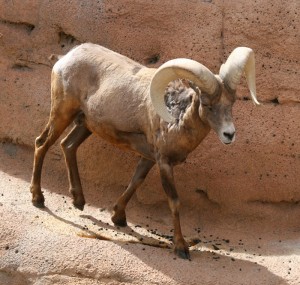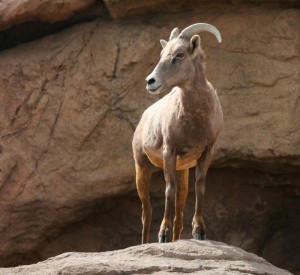
Bighorn Sheep – Ovis canadensis
General:
Bighorn sheep get their name for the large, curved horns on the rams. The ewes have horns but they are shorter with less curvature. The males are called rams while the females are called ewes.
Bighorn sheep are known for the male head-to-head combat during mating season. They charge each other at speeds of more than 20 mph. This is done to establish dominance hierarchy and access to ewes for mating.
Bighorn sheep live in herds or bands of about 5 to 15 ewes, lambs, yearlings, and two-year olds. Groups of males are much smaller, usually numbering two to five. In the winter, the ewe herds join to create bands of as many as 100 animals.
Identification:
As their name implies, male bighorn sheep have large curved horns that can weigh up to 30 lbs.
Bighorn sheep range in color from light brown to grayish or dark, chocolate brown, with a white rump and lining on the backs of all four legs. Males typically weigh 127 – 316 lbs. with an occasional ram from the Rocky Mountains reaching 500 lbs. Females typically weigh between 75 – 188 lbs. In height, the males are approximately 36” – 41” tall at the shoulder and 69” – 79” long. Females are approximately 30” – 36” tall and 54” – 67” long.
Habitat:
Bighorn sheep generally inhabit alpine meadows, grassy mountain slopes, and foothill country near rugged, rocky cliffs and bluffs. Since bighorn sheep cannot move though deep snow, they prefer drier slopes, where the annual snowfall is less than about 60 inches a year. A bighorn’s winter range usually lies at 2,500–5,000 feet in elevation, while its summer range is tends to be at 6,000–8,500 feet.
Territory:
Bighorn sheep were once widespread throughout western North America. By the 1920’s, bighorn sheep were eliminated from Washington, Oregon, Texas, North Dakota, South Dakota, Nebraska, and part of Mexico. Today, populations have been re-established through transplanting sheep from healthy populations into vacant places.
Diet:
Bighorn sheep are herbivores and as such graze on grasses and browse shrubs, particularly in fall and winter, and seek minerals at natural salt licks. During the summer, they subsist on grasses or sedges. During the winter they eat more woody plants, such as willow, sage and rabbit brush. Desert bighorn sheep eat brushy plants such as desert holly and desert cactus.
Interesting facts:
Recent genetic testing indicates three distinct subspecies:
1. Rocky Mountain bighorn sheep (O. c. canadensis), occupying the U.S. and Canadian Rocky Mountains and the northwestern U.S.
2. Sierra Nevada bighorn sheep (O. c. sierrae), formerly California bighorn sheep, a genetically distinct subspecies that only occurs in the Sierra Nevada
3. Desert bighorn sheep (Ovis canadensis nelsoni), occurring throughout the southwestern desert regions of U.S. and Mexico.
By 1900, the population had crashed to several thousand, due to diseases introduced through European livestock and overhunting. Conservation efforts (in part by the Boy Scouts) have restored the population.
Bighorn sheep are highly susceptible to certain diseases carried by domestic sheep. The National Park Service in Yellowstone, http://www.nps.gov/yell/naturescience/bighorninfo.htm, references an outbreak of pinkeye, a disease associated with domestic sheep, that caused a sharp decline in the Park’s bighorn sheep population in the early 1980’s.
Predation primarily occurs with lambs, which are hunted by coyotes, bobcats, lynxes and golden eagles. Bighorn sheep of all ages are threatened by bears, wolves and especially cougars
The lifespan of rams is typically 9–12 years, and 10–14 years for ewes.
The Rocky Mountain bighorn sheep is the provincial mammal of Alberta and the state animal of Colorado and as such is incorporated into the symbol for the Colorado Division of Parks and Wildlife.
They are legendary for their ability to climb high, steep, rocky mountain areas.
Back to Mammals